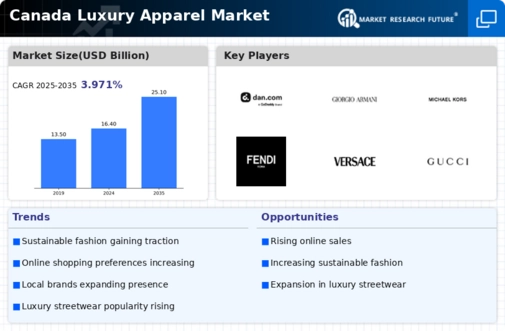E-commerce Expansion
The luxury apparel market in Canada is witnessing a significant shift towards e-commerce, which is reshaping consumer purchasing behavior. As of 2025, online sales in the luxury segment are projected to account for over 25% of total sales, reflecting a growing preference for digital shopping experiences. This trend is driven by the convenience and accessibility that e-commerce platforms offer, allowing consumers to explore a wide range of luxury brands from the comfort of their homes. Additionally, the rise of social media and influencer marketing has further propelled online engagement, enabling brands to reach a broader audience. The luxury apparel market is adapting to this digital transformation by enhancing their online presence and investing in user-friendly platforms. This shift not only caters to the evolving preferences of consumers but also opens new avenues for growth and customer acquisition in the competitive landscape of luxury fashion.
Rising Disposable Income
The luxury apparel market in Canada is experiencing growth driven by an increase in disposable income among consumers. As the economy strengthens, more individuals are willing to allocate a larger portion of their income towards luxury goods. In 2025, it is estimated that the average disposable income in Canada will rise by approximately 3.5%, allowing consumers to indulge in high-end fashion. This trend is particularly evident among millennials and Gen Z, who are increasingly prioritizing luxury brands that resonate with their values. The luxury apparel market is likely to benefit from this demographic shift, as younger consumers seek unique and high-quality products that reflect their personal style. Furthermore, the affluent segment of the population continues to expand, further fueling demand for luxury apparel. This increase in purchasing power is expected to sustain the growth trajectory of the luxury apparel market in Canada.
Sustainability and Ethical Practices
Sustainability has emerged as a crucial driver in the luxury apparel market in Canada, as consumers increasingly prioritize ethical practices in their purchasing decisions. In 2025, it is estimated that over 60% of Canadian consumers will consider sustainability when buying luxury goods. This shift is prompting brands to adopt eco-friendly materials and transparent supply chains, reflecting a commitment to environmental responsibility. The luxury apparel market is responding to this demand by implementing sustainable practices, such as using organic fabrics and reducing waste in production. Furthermore, brands that effectively communicate their sustainability efforts are likely to enhance their brand loyalty and attract environmentally conscious consumers. As the market evolves, the emphasis on sustainability is expected to shape the future of luxury fashion, driving innovation and redefining consumer expectations.
Cultural Influences and Fashion Trends
Cultural influences play a pivotal role in shaping the luxury apparel market in Canada. The increasing diversity within the Canadian population has led to a rich tapestry of fashion preferences, driving brands to adapt their offerings to cater to various cultural aesthetics. In 2025, it is anticipated that the demand for culturally inspired luxury apparel will rise by approximately 15%, as consumers seek products that resonate with their heritage and identity. This trend encourages luxury brands to collaborate with local designers and artists, fostering a sense of community and authenticity. The luxury apparel market is likely to benefit from this cultural shift, as brands that embrace inclusivity and diversity are more likely to attract a loyal customer base. By aligning their collections with cultural narratives, luxury brands can enhance their relevance and appeal in the Canadian market.
Influence of Social Media and Celebrity Endorsements
The impact of social media and celebrity endorsements on the luxury apparel market in Canada cannot be overstated. In 2025, it is projected that nearly 70% of luxury purchases will be influenced by social media platforms, as consumers increasingly turn to influencers and celebrities for fashion inspiration. This trend highlights the importance of digital marketing strategies for luxury brands, as they seek to engage with consumers through visually appealing content and authentic storytelling. The luxury apparel market is leveraging this influence by collaborating with high-profile figures to enhance brand visibility and credibility. Additionally, social media allows for real-time engagement with consumers, fostering a sense of community around luxury brands. As the digital landscape continues to evolve, the role of social media in shaping consumer preferences and driving sales in the luxury apparel market is expected to grow even further.























Leave a Comment